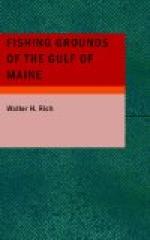“The herring left St. Andrews Bay and the North Shore about 1885. There is no summer netting there now. Those waters and Lepreau Bay were formerly very productive fishing grounds, it being not unusual to take 5,000 (count) big herrings (food fish) in a single haul. These were mainly spring and winter fishing grounds for large herring. The fish seem to have disappeared from all these grounds at about the same time.[10]
“In past years (25 to 30 years ago) small herring were driven ashore in such quantities by their enemies—squid, silver hake and dogfish—that it sometimes became necessary for the authorities at St. John to use a snowplow to cover them where they lay decaying on the beach.”
From the statistics of the sardine and smoked-herring industry for the year 1924 (a year, be it noted, in which the sardine industry almost reached low—level mark for the pack) the waters of the Bay of Fundy furnished to American purchasers alone a total of herring for smoking and canning purposes amounting to 76,756,250 pounds valued to the fishermen at $957,665. This showing, poor as it is when compared with the figures of other years, by no means represents the herring fishery as an unimportant industry. There still remains to be accounted for the catch of herring of Grand Manan and the neighboring Canadian Provinces.
A new source of profit to the fishermen in this industry has been developed in the purchase of herring scales by firms engaged in the manufacture of artificial pearls. For this purpose there were collected at Eastport and Lubec 700,000 pounds of herring scales, valued at $39,000; and a further amount was taken at Grand Manan of 140,000 pounds, valued at $7,000. With other entrants already in the field, this branch of the industry bids fair to grow to still greater importance.
An estimate of the number of weirs in St. Andrews Bay, by Capt. Guilford Mitchell of Eastport, Me., is as follows: Canadian: 1921: 126 weirs 1923: 40 weirs Calais to Eastport: 1921: 35 weirs; 1923: 7 weirs Total number in operation, 1923, Canadian, about 300; American less than 130.
North Shore and coast of Nova Scotia. Along the North Shore and from Yarmouth to Cape Sable, over a hard bottom, cod abound. The western shore of Nova Scotia is virtually all fishing ground for cod, haddock, hake, and cusk, but trawling is somewhat handicapped here by strong tides and rocky bottom, these combining to destroy much gear. Halibut are somewhat unusual on this western shore except about the mouth of the Bay of Fundy, but in summer these fish are occasionally found close inshore along the southwest coast, going somewhat beyond Digby to the northward. Haddocking is quite an important industry off Yarmouth, Nova Scotia, during the winter, the sets being of rather short duration and made at the slack of the tide at high water. This practice is made necessary by the heavy tidal currents on these grounds.




